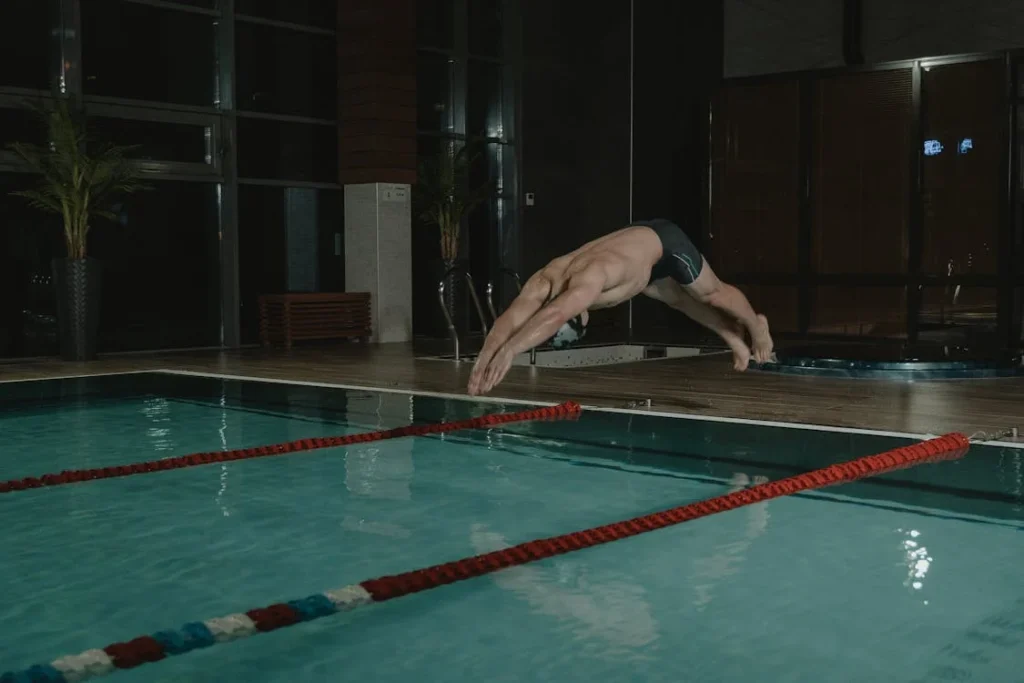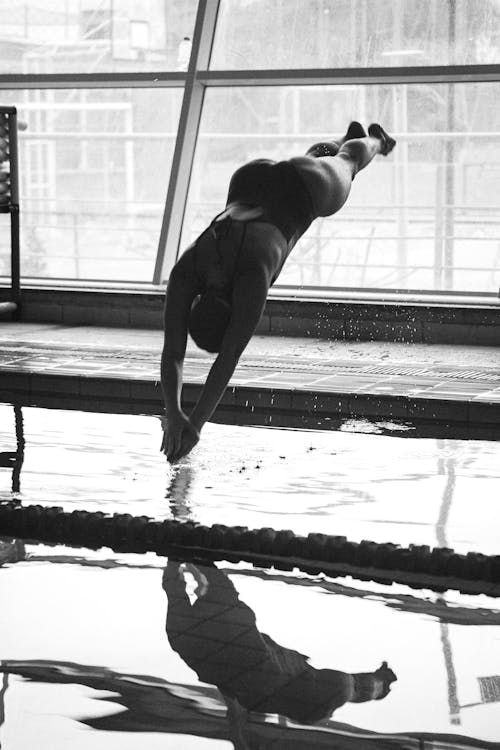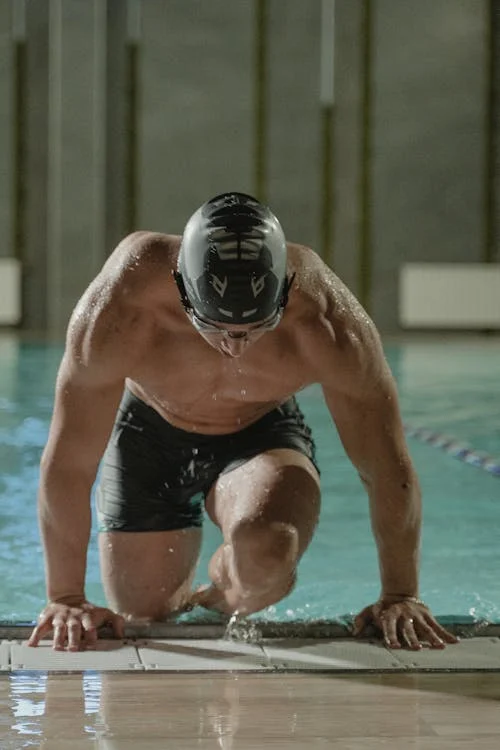Swimming is a great way to increase endurance, build strength, and lose weight. Whether you’re on a mission to get lean or just trying to improve your swimming performance, this article will give you some specific training secrets and workouts from swimmers’ training.
What Muscles Does Swimming Engage?
Swimming is a low-impact sport. It engages all the major muscle groups in your body, including your arms and shoulders, legs, core muscles, and back muscles, but the four main muscle groups used most when swimming are:
Abs Muscles
Swimming strengthens your abs by making you work your abdominal muscles to stay afloat in the water and push off the pool’s bottom to pull yourself back up. It also helps you maintain good posture while swimming by keeping your lower back straight.
Leg Muscles
The legs work as a team during backstroke and butterfly swimming to kick underwater and create powerful leg movements that help propel you through the water faster than other swimming strokes.
Triceps Muscles
Swimming engages the triceps muscle group, which helps you finish your pulls when performing freestyle, butterfly, and backstroke swims. Without the triceps strength, you will have to complete more strokes which may slow you down.
Lat Muscles
When swimming freestyle or butterfly, the lats are used to draw the upper arm downward and backward and rotate it inward. When swimming freestyle, you use your upper arms to propel yourself forward through the water with each stroke. While swimming butterfly, you use your lower body to propel yourself through the water with each stroke. Both strokes require strong shoulder muscles and upper arm and elbow strength.

Swimming is a great way to stay in shape, keep your body, mind, and heart healthy, and protect against disease. In addition to improving your cardiovascular health, swimming has many other benefits, which are:
Improved Muscle Tone
Swimming improves muscle tone by strengthening your arms, legs, and core muscles that support your spine when working out. It also builds your core strength which helps with balance and stability.
Promotes Weight Loss
Swimming is excellent for weight loss and can help quickly tone up your body. It can be a great alternative if you don’t like running. Typically, swimming can burn more calories than jogging in a short period. You burn more calories running over a longer period.
Reducing Stress
Swimming reduces stress levels. It is an effective form of meditation that can help you relax and release muscle tension because it takes such focus and concentration.
Swimming Improves Cardiovascular Health
Swimming improves cardiovascular health by strengthening your heart and lungs, improving blood circulation, reducing blood pressure, increasing bone density, and reducing stress.
Swimming Improves Strength and Endurance
Swimming builds strength and endurance in your arms and legs by building muscle mass faster, which helps with everyday tasks like climbing stairs and training. Swimming also requires constant movement, which helps develop lean muscle mass more than other exercises requiring little to no activity.
Promotes Muscle Recovery
Swimming is a low-impact, low-strain exercise that is easy on the joints or ligaments and you can do it daily. This makes it a good choice for you if you have experienced joint pain or other health concerns linked to high-impact sports. You can complement it with high-impact workouts to help muscle recovery and injury prevention.
Swimming improves balance, coordination, and agility, which can help prevent falls in older adults or those with Parkinson’s disease. It also improves concentration, which can help you with the ability to focus while training.

There are many ways to improve your swimming. A workout that helps you improve your swimming is a workout that builds strength and endurance, improves your flexibility and works on your mobility. They include:
1. Swimming Laps in Pool
Swimming laps can help increase your stamina and endurance. As you swim longer distances, your stroke becomes more efficient. This means it requires less effort than when you first started swimming, making it easier to continue swimming for more extended periods. You’ll also strengthen your muscles by swimming longer distances and holding them in a stretched position for extended periods.
When you start, focus on improving your turns and strokes by practicing every day until they become second nature to you.
2. Yoga
It is a great way to relax, which can help you to be more focused during different swimming strokes. Yoga also improves flexibility, which is essential for swimmers because it helps increase their range of motion. It also enhances balance and mobility – this can help improve your ability to swim freestyle.
Yoga also has many other health benefits, such as strengthening core muscles, better balance, improved breathing techniques, and quicker recovery after workouts. Here are some yoga moves that can help improve your swimming:
- Frog Pose:
- Warrior I
- Dolphin Pose
3. Squats
Squats are one of the most effective exercises for improving your swimming. They work your legs, hips, and core. There are many squats, but the most effective in swimming are squat jump and goblet squat.
To do a squat jump, stand with your feet shoulder-width apart and your arms at your sides. Bend your knees as you push off the ground, leap high into the air and then bring your knees back down to the starting position. Do the exercise thrice a week for about 15 minutes.
4. Lateral Lunge
Lateral lunge works your hips and groin muscles, enhancing hip rotation which is vital in swimming. It also promotes mobility.
To do the exercise, start by standing with your feet and your arms by your sides. Then step one leg out to the side, keeping your other foot planted firmly on the ground and the toes pointed ahead.
Squat onto your right leg, keeping your left leg straight and shifting the weight onto your right leg. Squat as low as you can and hold the position for three seconds. Return to the starting position and repeat for 10 reps before turning on the other side.
5. Dumbbell Deadlifts
Dumbbell deadlifts improve your swimming stroke by building your core and working on your back strength. How to do it:
Hold a dumbbell in each hand and stand with your feet shoulder-width apart. Lift the dumbbells in front of you, keeping them parallel to the ground and at arm’s length from your body. Lower the weights to the starting position, then repeat for 15 reps. If you’re using heavier weights, do fewer reps.
6. Pullups
Pull ups are a great exercise to improve your upper body strength. They work the back, lats, wrist and shoulder muscles, which help with swimming.
To do pull ups, grab a pullup bar with an overhand or underhand grip. Pull yourself up until your chin is above the bar by pulling your shoulder blades back and down. Lower yourself back down and repeat. You can also use a chin-up bar if you don’t have access to a pullup bar.
7. Single Arm- Dumbbell Row
The main muscles worked during this exercise are the rhomboids and latissimus dorsi. These muscles help pull your body up out of the water when you swim and assist in pulling yourself through the water during freestyle strokes.
To do the exercise, you will need a bench or a high platform to lean on while doing the practice and a dumbbell. Place the bench in a steady place, and then put a dumbbell on one side.
Put your left leg on the bench and hold the far end with your left hand. Lean forward until you feel a slight stretch in your lower back and your body is parallel to the ground. Reach down and grab a dumbbell with a neutral grip. Each time you lift the dumbbell, keep your back straight and your arms extended.
Inhale as you pull the weight up with your shoulders and back muscles until the dumbbell is even with your chest or slightly above it. Squeezing your shoulder and back muscles, exhale as you slowly lower the dumbbell back down by bending at your elbows until they are parallel to the ground and extending your arms. Repeat this movement 10 times before switching to your left.
8. Leg Cradle
This exercise helps open up the hips, which allows you to rotate in the pool water.
To do the exercise, lift your right foot from the ground and remain standing on your left foot. Raise your right knee and then place your right hand under it. While holding it, place your left hand under the ankle and pull your right leg as close as possible to your chest while you squeeze the left glute.
Return the foot to the ground. Do ten reps per set before switching to the left leg.
9. Glute Bridge
This workout improves hip flexibility, body shape, leaping ability and posterior strength by keeping the hips enlarged and engaging the hamstring muscles.
To perform the exercise, lie flat on your back with your knees bent and feet flat on the ground. Place your hands at your side with your palm facing downwards.
Raise your hips off the floor until your shoulder, back and knees form a straight line, and you feel a stretch in your lower back. Keep your arms at your sides and move only from the hip joints. Squeeze your glutes together and keep your abs drawn, so you don’t overextend your back during the exercise. Hold your bridged position for a couple of seconds before easing back down. Aim for two sets of ten bridges.
10. Kettlebell Goblet Squats
The kettlebell goblet squat is a total body weight training workout that works your legs, core, and glutes.
To perform the exercise, stand with your feet shoulder-width apart and hold a kettlebell by the handle with both hands in front of your chest, bringing your elbows toward your body.
Then bend at the hips, knees, and ankles until your thighs are parallel to the floor. Keep your back straight as you lower yourself down into a squat position.
Once in this position, push up through your heels while maintaining proper form by keeping everything tight. Pause briefly, then stand back up and repeat.

Every great swimmer has a training regime. Here are the three famous swimmers with their training regimes:
Swimmer Ryan Murphy
Ryan Murphy is a backstroker who has won three golds at the 2016 Rio Games and has held the world record for the 100-meter event.
A big part of his training regime is in the water; he goes to the pool daily. He also spends three hours in the weight room throughout the week working out.
Besides the training that gives him a fabulous look, he focuses on restoring his muscles, nutrition, and sleep. Here are some of the critical exercises of his training program:
- Physio Ball Scorpion 3 sets of 8 to 10 reps
- The Rhythm Clean and Jerk 3 sets of 3 to 5 reps
- Hanging Med Ball Throw 3 sets of 8 to 10 reps
- Swimming
Weighted Pull Ups (with Chain)
3 sets of 4 to 6 reps of each exercise
- Overhand Pull-ups
- Underhand Pullups
- Wide Grip Pull Ups
Swimmer Natalie Coughlin
Natalie Coughlin, is one of the best female swimmers of all time.Over her carrer, she whas won 60 medals at major international championships: 25 gold, 22 silver and 13 bronze.
When training, Natalie swims approximately eight times weekly, and each swim session lasts between an hour and a half and 2 hours. She also works out at the gym four times weekly for roughly the same amount of time, lifting weights and doing cross training. All told, she works out for close to 30 hours per week.
Swimmer James Guy Olympic Training Regime
James Guy competes for Team GB in swimming. He is a world and Commonwealth champion in the 200 and 400 meters freestyles events.
In his preparation for the 200m and 400m freestyles, he focuses on pecs, lats, and particular back muscles to assist him in interacting with the water. He must be robust and have muscular endurance to finish quickly in the race. He works out 11 times every week:
Day 1: two pool sessions, one early in the morning and one in the afternoon, both lasting two hours
Day 2: two pool sessions in the morning and two in the afternoon, each lasting two hours, with a weight workout in between
Day 3: three and a half hours of circuit training followed by a two-hour swim
Day 4: a single two-hour afternoon session
Day5: two-hour swim followed by an hour of cardio.
Day 6: two hours in the pool early morning
Day 7: Resting

Conclusion
The biggest takeaway from the article is that anyone can train like a swimmer. The training is not all-consuming nor impossible to fit into your schedule. It just takes some planning and dedication.




